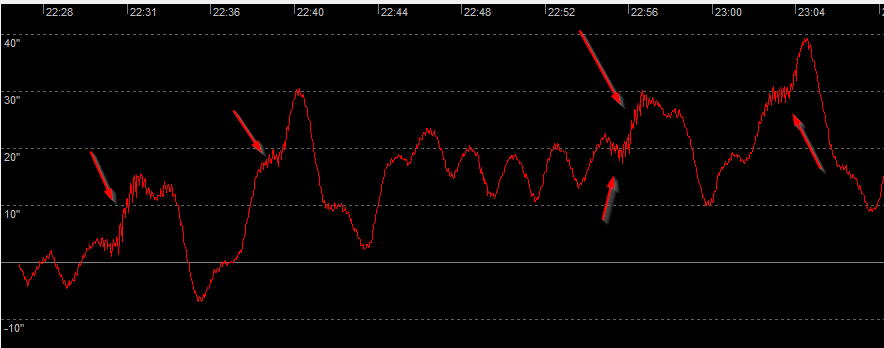Poor guiding
Malcolm Aucoin
Please review this guiding log file. You can see that the guiding is not very good. The last 2 sections, numbers 5 and 6, are about 50 minute logs with no guiding commands sent to the mount. Number 5 is 2 second exposures and #6 is 1 second exposures. After seeing these, I could understand why the guiding is so bad. Any help would be appreciated.
bw_m...@earthlink.net
Hi Malcom. I think you may have goofed up the configuration specifications here. Based on your message, your guide scope focal length should be 430mm – but the PHD2 profile you’re using says it’s 914mm. That makes It harder for us to analyze your logs but if this really is goofed up, the guiding is actually even worse than you think. I think you should start over and get a clean baseline measurement of your mount’s capabilities by following this procedure:
All of that said, I think we’re going to find a mechanical problem in your RA drive system that’s shown here - indicated by the arrows - in this unguided section of the log:

These “rough patches” produce rapid RA tracking errors that are actually quite large and really degrade the overall poor RA performance. Once we get a clean baseline from you, we can probably say more. When you are ready to upload the data, please use the built-in Upload Logs feature described here:
https://openphdguiding.org/getting-help/
Regards,
Bruce
--
You received this message because you are subscribed to the Google Groups "Open PHD Guiding" group.
To unsubscribe from this group and stop receiving emails from it, send an email to open-phd-guidi...@googlegroups.com.
To view this discussion on the web visit https://groups.google.com/d/msgid/open-phd-guiding/bbc42a0f-8c76-4b03-8508-413e2abae7a5n%40googlegroups.com.
Malcolm Aucoin
You received this message because you are subscribed to a topic in the Google Groups "Open PHD Guiding" group.
To unsubscribe from this topic, visit https://groups.google.com/d/topic/open-phd-guiding/pf2gJvOhJx4/unsubscribe.
To unsubscribe from this group and all its topics, send an email to open-phd-guidi...@googlegroups.com.
To view this discussion on the web visit https://groups.google.com/d/msgid/open-phd-guiding/001c01d924af%2413a7a190%243af6e4b0%24%40earthlink.net.
Malcolm Aucoin
You received this message because you are subscribed to a topic in the Google Groups "Open PHD Guiding" group.
To unsubscribe from this topic, visit https://groups.google.com/d/topic/open-phd-guiding/pf2gJvOhJx4/unsubscribe.
To unsubscribe from this group and all its topics, send an email to open-phd-guidi...@googlegroups.com.
To view this discussion on the web visit https://groups.google.com/d/msgid/open-phd-guiding/001c01d924af%2413a7a190%243af6e4b0%24%40earthlink.net.
Bruce Waddington
Malcolm Aucoin
bw_m...@earthlink.net
Hi Malcolm. I don’t think you’re doing anything wrong, I think there’s a problem with the mount. One thing you can do just to be absolutely sure is enable the ‘Show Advanced Options” checkbox in the EQMOD ASCOM setup dialog. That will expose one more control which is a pulse-guide override option. That must be set to zero and it almost certainly is, but best to be sure.
The problem is that even with all the correct settings, the calibration movements are much faster than they should be. The computed RA and Dec rates that PHD2 is seeing are over 50% higher than the reported mount guide speeds. Another question is whether the pixel size is correct for whatever DSI camera model you’re using. The Meade camera driver doesn’t report the actual pixel size so PHD2 is using fixed values based on the DSI model name. The 8.3u size in your logs is based on the assumption you’re using a DSI II. Can you confirm that is correct? If any of the parameters that affect the calculation of the guider image scale are wrong – focal length, pixel size, camera binning – the performance numbers we’re looking at will be wrong.
To view this discussion on the web visit https://groups.google.com/d/msgid/open-phd-guiding/83838d10-5d9b-4709-bb87-7d9f695d027en%40googlegroups.com.
Malcolm Aucoin
To view this discussion on the web visit https://groups.google.com/d/msgid/open-phd-guiding/001b01d925f1%2419e870f0%244db952d0%24%40earthlink.net.
bw_m...@earthlink.net
Ok, then it sounds like all the settings are right. Since we know our measurement scale is right, the reason the RA and Dec rates are “too high” is probably because there’s a problem in the mount firmware or hardware. I’ll offer an analogy about “fudging” the parameters for this sort of thing. Suppose I have an older car with a dial-type speedometer. Could I draw an overlay for the speedometer dial with more tightly spaced speed numbers and tell everyone the car can go 200mph? 😊 As I said originally, these measurement oddities are just symptoms of problems in the mount, just as the rapid oscillations shown in the GA graph indicate mechanical problems. The problem is not with the guiding, it’s the equipment. I think your goal should be to demonstrate the problem very clearly and then try to get help from the mount manufacturer.
To view this discussion on the web visit https://groups.google.com/d/msgid/open-phd-guiding/CAE-%2B6gNO9mHtuYOqYFPqBbmcARQKZhx%2BEaxESbCj7apd0nm6vA%40mail.gmail.com.
rasalg...@gmail.com
If the version of the mount is 1.06 you have to put drift compensation in 3.
Regards.
